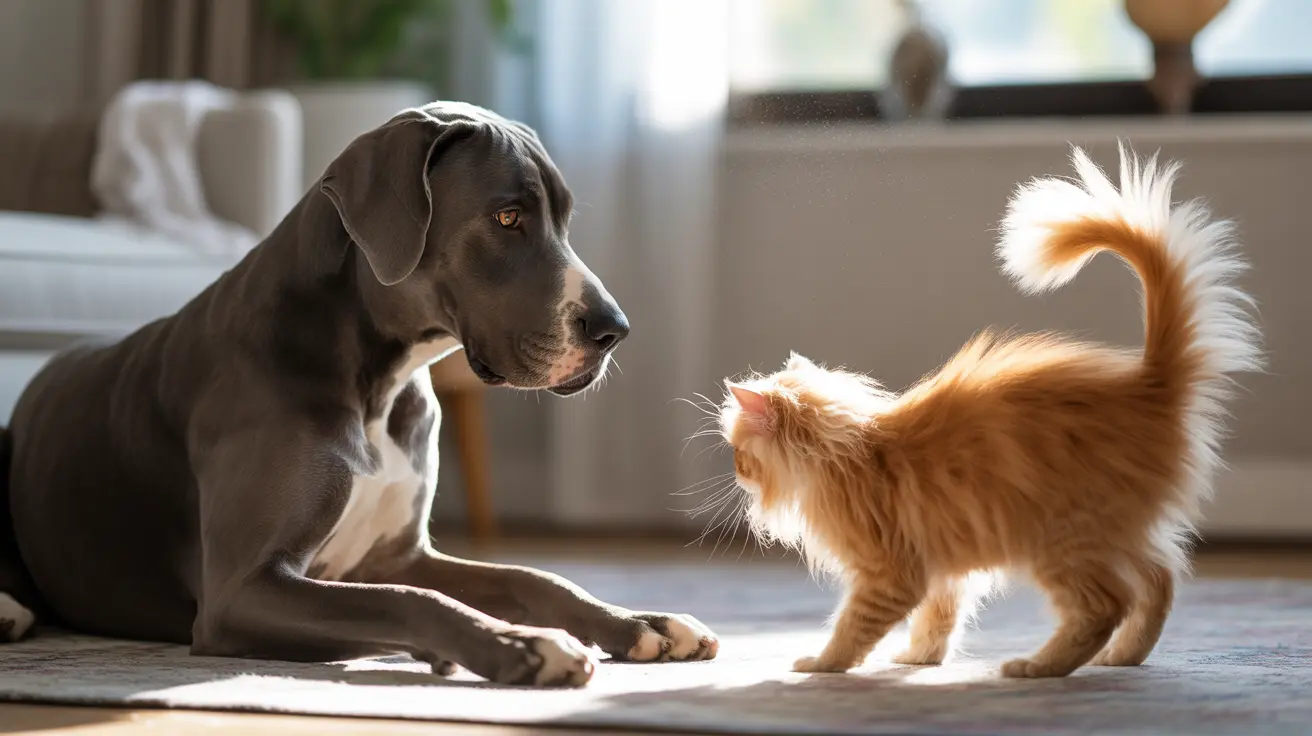If you're considering adding a Great Dane to your cat-loving household or vice versa, you might be wondering about their compatibility. Great Danes, despite their imposing size, are often referred to as "gentle giants" for good reason. These majestic dogs can indeed develop wonderful relationships with cats, but success depends on several crucial factors.
In this comprehensive guide, we'll explore the unique dynamics between Great Danes and cats, offering expert insights on creating harmonious multi-pet households.
Understanding Great Dane Temperament
Great Danes possess a naturally gentle and patient disposition that can work in their favor when it comes to cat relationships. Their calm demeanor and relatively low prey drive compared to other large breeds make them potentially excellent companions for feline friends.
However, it's important to note that each dog is unique, and individual personality traits can significantly impact their ability to peacefully coexist with cats.
The Role of Early Socialization
Early exposure to cats plays a crucial role in determining how well a Great Dane will interact with felines throughout their life. Puppies introduced to cats between 3-12 weeks of age typically develop the most positive relationships with them.
Adult Great Danes who have never encountered cats may require more time and patience during the introduction process, though successful integration is still possible with proper training and management.
Creating a Successful Introduction
Preparation Phase
Before the first meeting, ensure both pets have their own safe spaces. Set up vertical escape routes for your cat and prepare separate areas for feeding, sleeping, and bathroom needs.
Controlled Meetings
Begin with barrier introductions using baby gates or screen doors. This allows both animals to see and smell each other without direct contact. Watch for positive body language such as relaxed postures and curious interest.
Gradual Progress
Once both pets show comfort with barrier meetings, proceed to supervised face-to-face interactions. Keep your Great Dane leashed initially, and reward calm, non-aggressive behavior from both animals.
Managing the Relationship Long-term
Successful cohabitation requires ongoing management and attention to both pets' needs. Maintain separate feeding areas and ensure cats have access to high places where they can observe their environment safely.
Regular exercise and mental stimulation for your Great Dane can help prevent unwanted chasing behaviors and promote calmer interactions with their feline housemates.
Potential Challenges and Solutions
The most common challenge is the size disparity between Great Danes and cats. Some cats may feel intimidated by these gentle giants. Creating multiple escape routes and elevated spaces can help cats feel more secure.
Watch for signs of stress or anxiety in either pet, such as excessive hiding, aggressive behavior, or changes in eating habits. Address these issues promptly with positive reinforcement training or professional help if needed.
Frequently Asked Questions
Are Great Danes naturally good with cats, or does their behavior depend on socialization?
While Great Danes have a generally gentle nature, their behavior with cats primarily depends on socialization. Early exposure and positive experiences with cats significantly increase the likelihood of good relationships, though individual temperament also plays a role.
How should I properly introduce my Great Dane to a cat to ensure they get along?
Start with separate spaces and barrier introductions, gradually progressing to supervised face-to-face meetings. Keep your Great Dane leashed initially, and always reward calm, appropriate behavior from both animals. The process may take days to weeks, depending on both pets' personalities.
Can the large size of a Great Dane frighten cats, and how can I help them adjust?
Yes, a Great Dane's size can intimidate cats initially. Help cats adjust by providing plenty of vertical space, safe zones, and escape routes. Never force interactions, and let the cat set the pace for engagement.
What signs of stress or aggression should I watch for when my Great Dane meets a cat?
Watch for fixation, stalking, excessive barking, growling, or lunging from your Great Dane. In cats, look for hissing, spitting, flattened ears, puffed fur, or hiding behavior. If you notice these signs, separate the animals and slow down the introduction process.
How important is early socialization in preventing a Great Dane from chasing or barking at cats?
Early socialization is crucial for preventing chase behaviors and promoting positive interactions. Great Danes socialized with cats during their critical development period (3-12 weeks) are much more likely to view cats as family members rather than prey.






